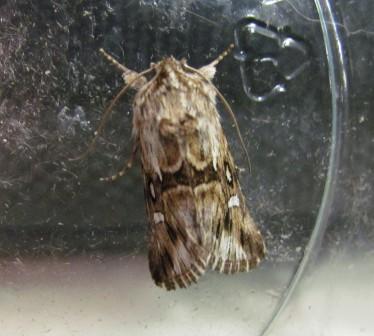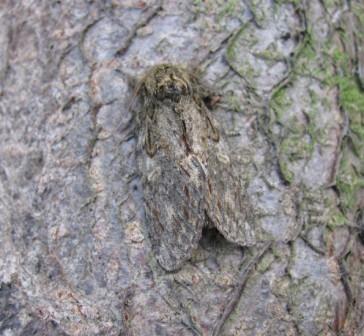May 16th : Along with Andy McGheeny, Martin McCleary and Anthony Harbott I helped out with a National Moth Night event at Epping Field Centre. Around a dozen members of the public attended and, as usual, I was pleasantly surprised by the level of interest shown. With persistent north-east winds, sunny days and cold nights the spring had been one of the poorest on record in my garden at Ingatestone, where I have been trapping regularly for around twenty years; thus I was not too hopeful that we would catch much, especially as there were clear skies at dusk and a predicted temperature of around 4`C. Five traps were set around the centre and by the end of the evening our tally had struggled to thirteen macro moths of nine species. Still, there were one or two nice things among them including Water Carpet, Orange Footman and Nut Tree Tussock but just as much excitement was caused by the commoner but brightly coloured Brimstone Moth. All in all, a successful evening. The most remarkable capture, however, was made by Martin McCleary in his Epping garden the previous evening. This was a Toadflax Brocade (top picture) , a European species that is on the edge of its range in Britain and which did not colonise our shores until the early 1950s. It is still largely confined to shingle beaches at Dungeness and adjacent areas although there have been a number of records from the Dovercourt area during the early part of this decade (Goodey 2004, p.293) and may possibly be colonising the beaches there. Shingle ridges are in short supply at Epping but the caterpillars' food plants, Common Toadflax and, increasingly, Purple Toadflax are not. Even so it is a totally unexpected record but, amazingly, Steve Wilkinson caught one in his garden at Chelmsford on the very same night! A species on the move it would appear. Coincidence? A fluke? Our warming climate? Time will tell. The best I could do in my own garden at Ingatestone (where I left a UV trap set all night) was a single Great Prominent (second picture)
, a European species that is on the edge of its range in Britain and which did not colonise our shores until the early 1950s. It is still largely confined to shingle beaches at Dungeness and adjacent areas although there have been a number of records from the Dovercourt area during the early part of this decade (Goodey 2004, p.293) and may possibly be colonising the beaches there. Shingle ridges are in short supply at Epping but the caterpillars' food plants, Common Toadflax and, increasingly, Purple Toadflax are not. Even so it is a totally unexpected record but, amazingly, Steve Wilkinson caught one in his garden at Chelmsford on the very same night! A species on the move it would appear. Coincidence? A fluke? Our warming climate? Time will tell. The best I could do in my own garden at Ingatestone (where I left a UV trap set all night) was a single Great Prominent (second picture) , a species scarce in Essex and largely confined to mature oak woodland. A single moderate sized oak in a neighbour's garden seems to have been the lure for this one.
, a species scarce in Essex and largely confined to mature oak woodland. A single moderate sized oak in a neighbour's garden seems to have been the lure for this one.
 , a European species that is on the edge of its range in Britain and which did not colonise our shores until the early 1950s. It is still largely confined to shingle beaches at Dungeness and adjacent areas although there have been a number of records from the Dovercourt area during the early part of this decade (Goodey 2004, p.293) and may possibly be colonising the beaches there. Shingle ridges are in short supply at Epping but the caterpillars' food plants, Common Toadflax and, increasingly, Purple Toadflax are not. Even so it is a totally unexpected record but, amazingly, Steve Wilkinson caught one in his garden at Chelmsford on the very same night! A species on the move it would appear. Coincidence? A fluke? Our warming climate? Time will tell. The best I could do in my own garden at Ingatestone (where I left a UV trap set all night) was a single Great Prominent (second picture)
, a European species that is on the edge of its range in Britain and which did not colonise our shores until the early 1950s. It is still largely confined to shingle beaches at Dungeness and adjacent areas although there have been a number of records from the Dovercourt area during the early part of this decade (Goodey 2004, p.293) and may possibly be colonising the beaches there. Shingle ridges are in short supply at Epping but the caterpillars' food plants, Common Toadflax and, increasingly, Purple Toadflax are not. Even so it is a totally unexpected record but, amazingly, Steve Wilkinson caught one in his garden at Chelmsford on the very same night! A species on the move it would appear. Coincidence? A fluke? Our warming climate? Time will tell. The best I could do in my own garden at Ingatestone (where I left a UV trap set all night) was a single Great Prominent (second picture) , a species scarce in Essex and largely confined to mature oak woodland. A single moderate sized oak in a neighbour's garden seems to have been the lure for this one.
, a species scarce in Essex and largely confined to mature oak woodland. A single moderate sized oak in a neighbour's garden seems to have been the lure for this one.
















